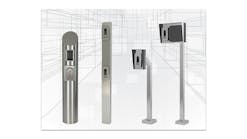Code Requirements for Stairwell Doors
Stairwell reentry is an important feature of life safety, and the requirements are often misunderstood or stair doors modified after the building is completed. With proper attention and education, tragedies like the death of six people in the stairwell of Chicago’s Cook County Administration Building (2003) may be averted.
Commercial building stairwell doors often are locked on the stair side to prevent unauthorized entry from the stairwells into tenant spaces. The term “stairwell reentry” refers to the code requirements which allow a building occupant to leave a stairwell during a fire emergency, and find another exit. If stairwell doors do not allow for reentry and a stairwell becomes impassible, it can jeopardize the lives of those using the stairwell as a means of egress.
There are quite a few myths surrounding this requirement, which I will address below.
Myth: Only high-rise buildings are required to comply with stairwell reentry requirements.
Fact: There have been many changes to this section of the code in the last 10 years, which is why there is so much confusion surrounding it. The 2000 edition of the International Building Code (IBC) and the model building codes that existed prior contained reentry requirements for high-rise buildings, but required passage sets for stair doors that were not in high-rise buildings. The failsafe locks or failsafe exit device trim required for reentry were sometimes allowed in buildings that were not high-rise buildings, but there was no option in the IBC or the model codes for mechanical locks on stair doors, except the stair discharge.
The 2003 edition of the IBC added an exception which allowed mechanical locks on stair doors if the stair was serving 4 stories or less, but the change was short-lived. In the 2006 edition of the IBC, that exception was changed to require remote unlocking from the fire command center or a location inside the building’s main entrance, effectively removing the exception for mechanical locks. This language remained unchanged in the 2009 edition of the IBC, and the 2012 edition is basically the same with the addition of language pertaining to certain occupancies with a single exit stair.
Although NFPA 101 – The Life Safety Code, and NFPA 5000 – The Building Construction and Safety Code DO allow mechanical locks on stair doors serving 4 stories or less, this only applies to buildings where one of these codes is being enforced. The IBC is currently the predominant building code for most jurisdictions, and the majority of buildings must be built in accordance with the IBC.
Myth: The door to every fifth floor must be unlocked, but the doors to the rest of the floors can be locked.
Fact: The requirement for every fifth floor to be unlocked is part of the “selected reentry” conditions in NFPA 101 – The Life Safety Code and NFPA 5000 – The Building Construction and Safety Code. This section requires at least two doors in a stair to be unlocked, no more than four locked floors between unlocked floors, either the top or next to top level must be unlocked and must allow access to another exit, the doors allowing reentry must be marked as such, and doors not allowing reentry must have signage which indicates the closest unlocked door in each direction. Again, this only applies to buildings where one of these codes is being enforced – the IBC does not include the selected reentry option. I have only seen selected reentry used on one project that I have specified, and in my opinion the codes were being creatively applied in that case.
Myth: A failsafe electric strike can be used on a stair door to provide reentry.
Fact: Stair doors providing reentry typically have a failsafe lock or failsafe exit device trim, which unlocks the lever handle upon fire alarm / power failure, but does not unlatch the door. A failsafe electric strike will not maintain the positive latching required for fire rated doors, and the pressure from a fire could push the door open, allowing smoke and flames to enter the stairwell. The IBC specifically states that stair doors must unlock “without unlatching.”
Another type of electrified hardware is occasionally used for stairwell reentry – sometimes called a “Hitower Lock” (a brand name). This is a frame-mounted device that controls the locking/unlocking via a lock modification. It’s not an electric strike, but it mounts in the same location so it could be confused with one.
Myth: The stairwell reentry requirements state that stair doors must unlock automatically upon fire alarm.
Fact: There is a slight distinction between codes, but the IBC states that the stair doors must be “capable of being unlocked simultaneously without unlatching upon a signal from the fire command center, if present, or a signal by emergency personnel from a single location inside the main entrance to the building,” while NFPA 101 states that “an automatic release that is actuated with the initiation of the building fire alarm system shall be provided to unlock all stair enclosure doors to allow re-entry.” The same type of hardware – failsafe locks or failsafe exit device trim – is used in either case, but the fire alarm interface will be different. There are additional requirements for two-way communication in the stairwell when stair doors do not allow free access at all times.
Myth: Both sides of a stair door can be locked as long as the door unlocks upon fire alarm.
Fact: I can’t count the number of times an architect or end user has asked me to specify hardware for a door that is locked all the time except during a fire alarm. If a door is a required egress door, VERY limited applications would allow the door to be locked in the direction of egress. NFPA 101 lists exceptions for certain existing occupancies, buildings permitted to have a single exit, and certain health care and detention/correctional occupancies. Most stair doors must allow free egress from the non-stair side at all times, and if there is a need to limit egress the two options would be delayed egress hardware which delays egress for 15 seconds, or an alarm to discourage use of the door. Note that delayed egress locks are not allowed in every occupancy type, and there are additional code requirements for doors equipped with delayed egress locks.
Myth: Stair discharge doors opening to the exterior must unlock automatically upon fire alarm to allow firefighter access to the stair.
Fact: The IBC specifically states that “stairway discharge doors shall be openable from the egress side and shall only be locked from the opposite side.” There is no requirement in the IBC or NFPA 101/5000 for the exterior doors to automatically unlock and provide firefighter access, although it may be required by some local jurisdictions. Unlocking these doors automatically upon fire alarm would impact the building’s security, and there are other ways for firefighters to gain access. If remote release of the stair discharge doors is required by a local jurisdiction, I would highly recommend that these doors be controlled by a switch at the fire command center, rather than unlocked automatically upon fire alarm.
Lori Greene, AHC/CDC, CCPR, FDAI, is Spec Team Lead - New England, Ingersoll Rand Security Technologies, based in Needham, MA. E-mail her at [email protected] or visit www.idighardware.com, a website offering answers to door, hardware, and code questions from Ingersoll Rand Security Technologies.

Lori Greene, DAHC/CDC, CCPR, FDAI, FDHI
Lori Greene, DAHC/CDC, CCPR, FDAI, FDHI, is manager, codes and resources at Allegion. Visit her website, idighardware.com.






